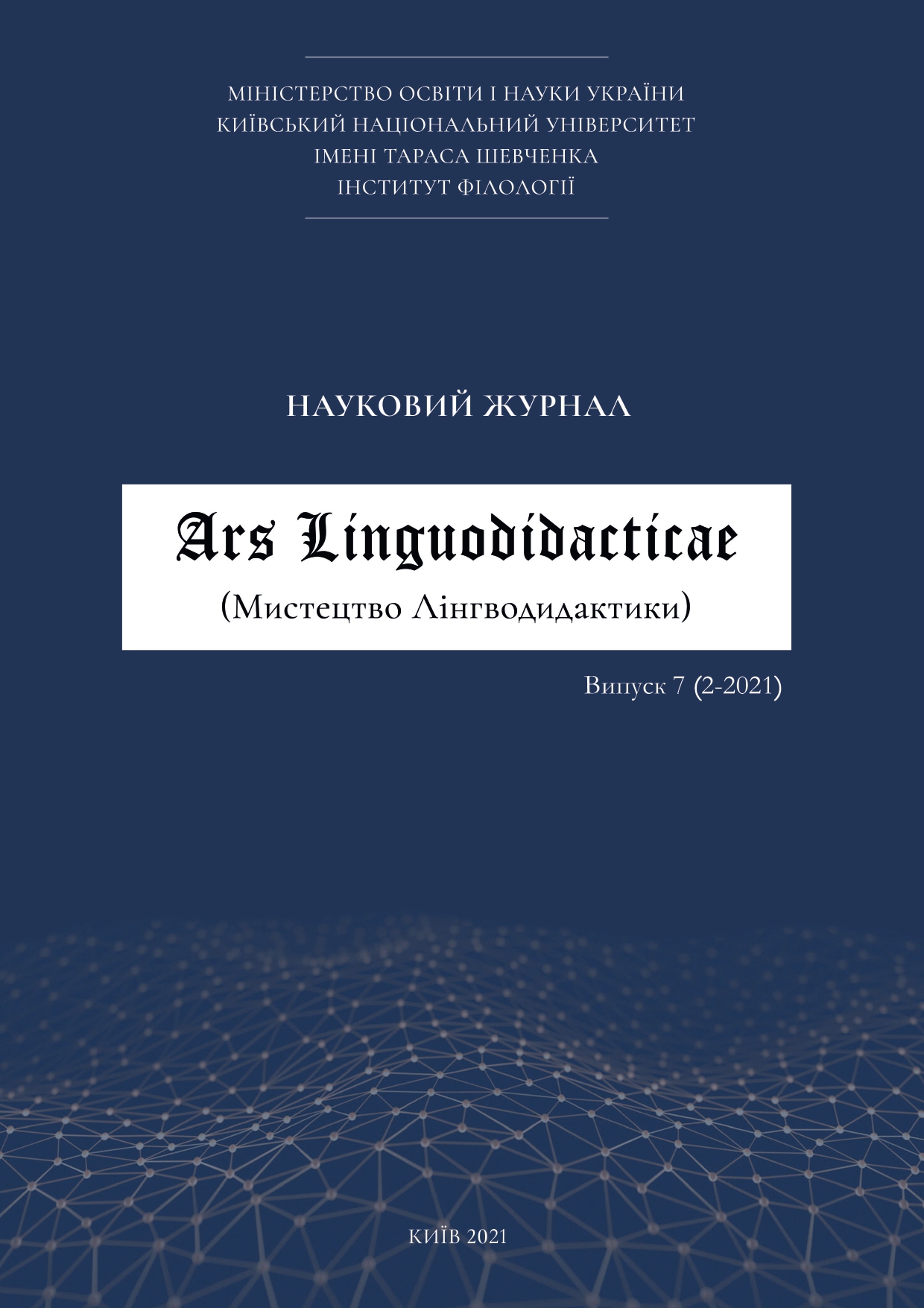ПОДОЛАННЯ КОМУНІКАТИВНИХ БАР’ЄРІВ НА УРОКАХ ІНОЗЕМНОЇ МОВИ В 6-МУ КЛАСІ СЕРЕДНЬОЇ ШКОЛИ
DOI:
https://doi.org/10.17721/2663-0303.2021.7.01Анотація
Стаття присвячена проблемі подолання комунікативних бар’єрів в учнів загальноосвітніх навчальних закладів, зокрема 6 класу, під час вивчення іноземної мови і пошуку шляхів її розв’язання. Досліджено поняття «комунікативний бар’єр» і запропоновано власне трактування терміну. Визначено педагогічні і психологічні умови подолання труднощів іншомовного спілкування в учнів молодшого підліткового віку. З’ясовано, що використання методу гри на уроці сприяє підвищенню комунікативної діяльності учнів та зменшенню в них страху спілкування. Авторами запропоновано комплекс ігор для учнів 6 класу, спрямований на подолання в них комунікативних бар’єрів під час іншомовного спілкування. Ефективність розробленої методики було перевірено на практиці. Отримані результати засвідчили, що використання комунікативних ігор на уроках іноземної мови здійснює позитивний вплив на емоційний стан учнів, їхню комунікативну активність, вмотивовує процес навчання та сприяє набуттю комунікативного й соціального досвіду школярів.
Ключові слова: комунікативний бар`єр, іншомовне спілкування, комунікативна гра, учні 6 класу, середня школа Стаття присвячена проблемі подолання комунікативних бар’єрів в учнів загальноосвітніх навчальних закладів, зокрема 6 класу, під час вивчення іноземної мови і пошуку шляхів її розв’язання. Досліджено
поняття «комунікативний бар’єр» і запропоновано власне трактування терміну. Визначено педагогічні
і психологічні умови подолання труднощів іншомовного спілкування в учнів молодшого підліткового віку.
З’ясовано, що використання методу гри на уроці сприяє підвищенню комунікативної діяльності учнів та
зменшенню в них страху спілкування. Авторами запропоновано комплекс ігор для учнів 6 класу, спрямований на подолання в них комунікативних бар’єрів під час іншомовного спілкування. Ефективність розробленої методики було перевірено на практиці. Отримані результати засвідчили, що використання
комунікативних ігор на уроках іноземної мови здійснює позитивний вплив на емоційний стан учнів, їхню
комунікативну активність, вмотивовує процес навчання та сприяє набуттю комунікативного й соціального досвіду школярів.
Ключові слова: комунікативний бар`єр, іншомовне спілкування, комунікативна гра, учні 6 класу, середня школа
##submission.downloads##
Опубліковано
Як цитувати
Номер
Розділ
Ліцензія
Авторське право (c) 2021 Наталія Сорокіна, Вероніка Дяченко

Ця робота ліцензується відповідно до Creative Commons Attribution-ShareAlike 4.0 International License.
Ця робота ліцензується відповідно до Creative Commons Attribution-NonCommercial 4.0 International License.
Політика охорони авторських прав відповідно до умов ліцензії: Creative Commons Attribution-NonCommercial (Атрибуція-Некомерційне використання) 4.0 Міжнародна (CC BY-NC 4.0).
Автори, що публікують свої статті в журналі "Ars Linguodidacticae" (журналі відкритого доступу) зберігають за собою такі права:
- Автори зберігають за собою права на авторство своєї статті та надають журналу "Ars Linguodidacticae" право першої публікації рукопису своєї статті на умовах ліцензії Creative Commons (CC BY-NC 4.0) Attribution License, яка дозволяє іншим особам вільно розповсюджувати опубліковану роботу з обов'язковим посиланням на автора оригінальної роботи та першу оригінальну публікацію в журналі "Ars Linguodidacticae". Інформація про збереження права на авторство надається на титульній сторінці статті.
- Автори зберігають за собою право укладати окремі угоди на неексклюзивне розповсюдження своєї статті у тому вигляді, в якому вона була опублікована в журналі "Ars Linguodidacticae" (наприклад, розміщувати статтю в електронних бібліотеках, архівах та каталогах або публікувати у складі інститутських збірників та монографій), за умови обов'язкового повного посилання на першу оригінальну публікацію в журналі "Ars Linguodidacticae".
- Політика журналу "Ars Linguodidacticae" дає змогу та заохочує розміщення авторами в мережі Інтернет (наприклад в інститутському репозитарії або на персональному сайті) рукопису роботи як до її подання до редакції, так і під час її редакційного опрацювання, оскільки це сприяє продуктивній науковій дискусії та позитивно позначається на оперативності й динаміці цитування статті.
Редакція журналу зберігає за собою видавничі права на:
- зверстані оригінали статей та весь номер журналу;
- оформлення журналу, а також оригінальні ілюстративні та додаткові матеріали;
- репринтні перевидання журналу в друкованому та електронному вигляді.
Політика охорони авторських прав провадиться відповідно до умов ліцензії: Creative Commons Attribution-NonCommercial (Атрибуція-Некомерційне використання) 4.0 Міжнародна (CC BY-NC 4.0).
Для отримання додаткової інформації, будь ласка, прочитайте повний текст Публічної ліцензії CC BY-NC 4.0
Creative Commons Attribution-NonCommercial 4.0 International License.


